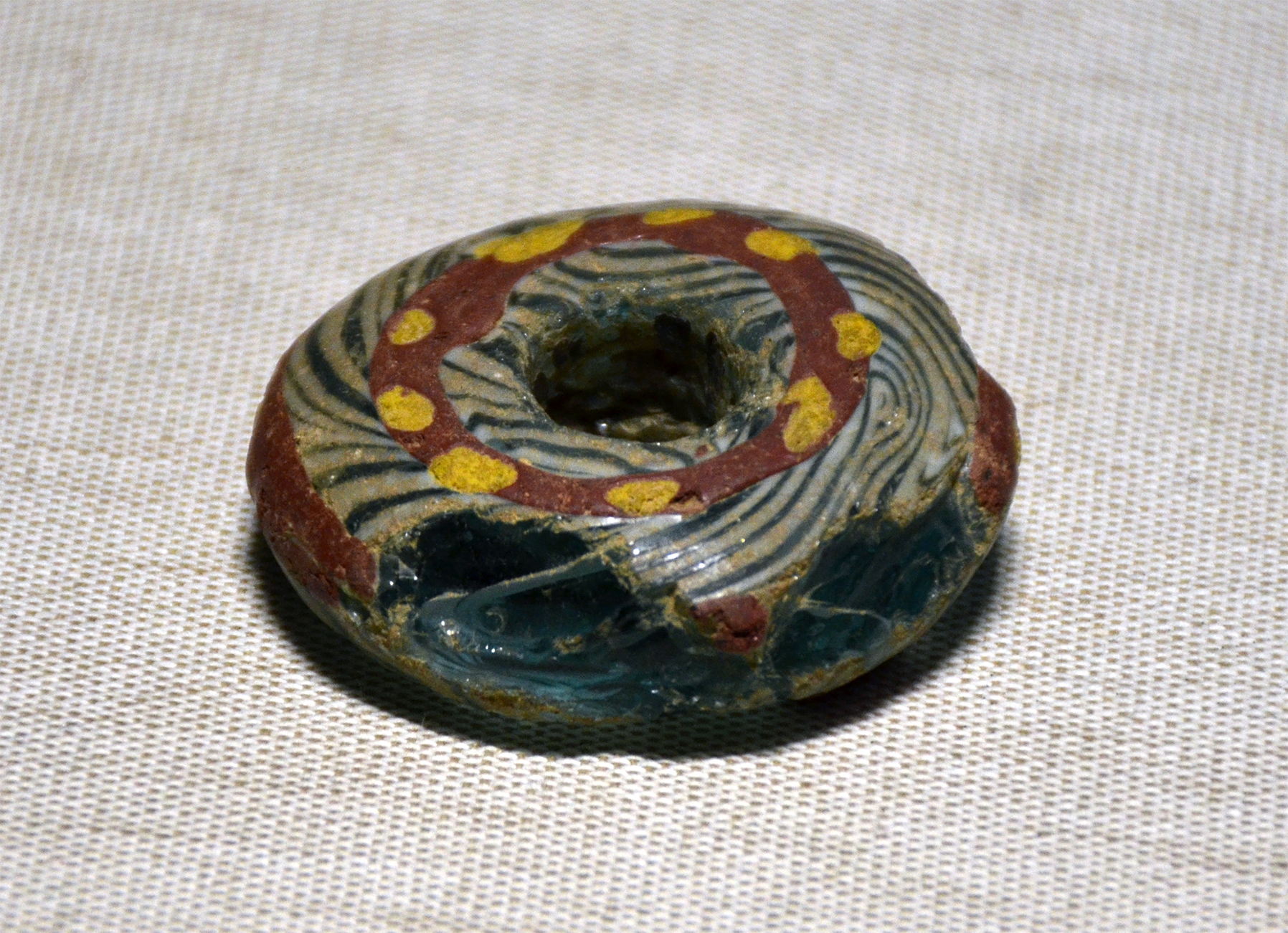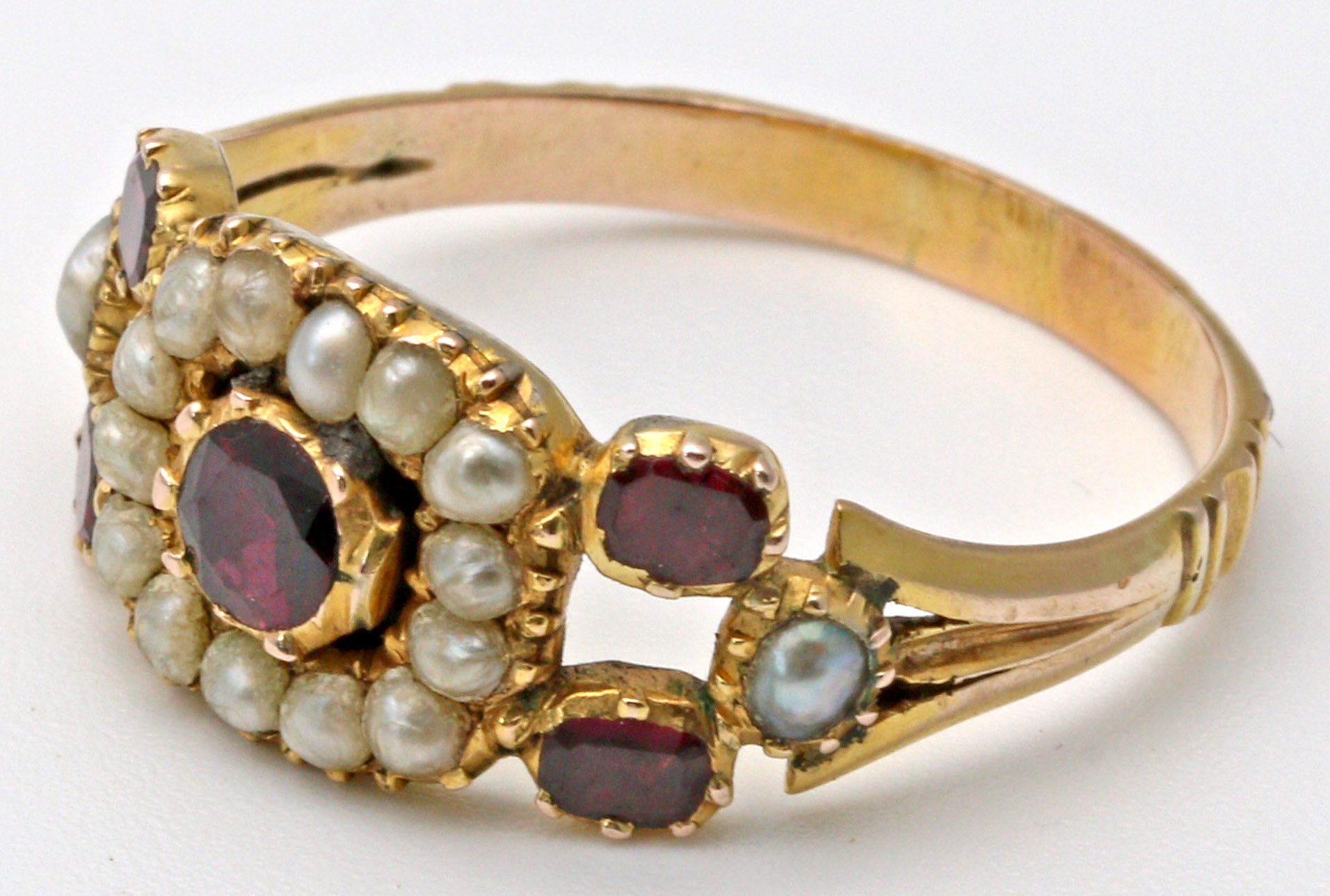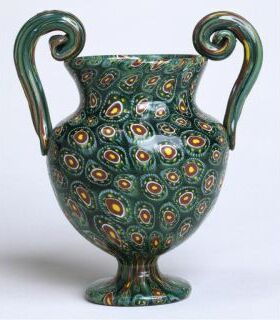|
Bead
A bead is a small, decorative object that is formed in a variety of shapes and sizes of a material such as stone, bone, shell, glass, plastic, wood, or pearl and with a small hole for threading or stringing. Beads range in size from under to over in diameter. Beads represent some of the earliest forms of jewellery, with a pair of beads made from '' Nassarius'' sea snail shells dating to approximately 100,000 years ago thought to be the earliest known example. Beadwork is the art or craft of making things with beads. Beads can be woven together with specialized thread, strung onto thread or soft, flexible wire, or adhered to a surface (e.g. fabric, clay). Types of beads Beads can be divided into several types of overlapping categories based on different criteria such as the materials from which they are made, the process used in their manufacturing, the place or period of origin, the patterns on their surface, or their general shape. In some cases, such as millefiori an ... [...More Info...] [...Related Items...] OR: [Wikipedia] [Google] [Baidu] |
Beadwork
Beadwork is the art or craft of attaching beads to one another by stringing them onto a thread or thin wire with a sewing or beading needle or sewing them to cloth. Beads are produced in a diverse range of materials, shapes, and sizes, and vary by the kind of art produced. Most often, beadwork is a form of personal adornment (e.g. jewelry), but it also commonly makes up other artworks. Beadwork techniques are broadly divided into several categories, including loom and off-loom weaving, stringing, bead embroidery, bead crochet, bead knitting, and bead tatting. Ancient beading The art of creating and utilizing beads is ancient, and ostrich shell beads discovered in Africa can be carbon-dated to 10,000 BC. Faience beads, a type of ceramic created by mixing powdered clays, lime, soda, and silica sand with water until a paste forms, then molding it around a stick or straw and firing until hard, were notably used in ancient Egyptian jewelry from the First Dynasty (beginni ... [...More Info...] [...Related Items...] OR: [Wikipedia] [Google] [Baidu] |
Jewellery
Jewellery ( UK) or jewelry ( U.S.) consists of decorative items worn for personal adornment, such as brooches, rings, necklaces, earrings, pendants, bracelets, and cufflinks. Jewellery may be attached to the body or the clothes. From a western perspective, the term is restricted to durable ornaments, excluding flowers for example. For many centuries metal such as gold often combined with gemstones, has been the normal material for jewellery, but other materials such as glass, shells and other plant materials may be used. Jewellery is one of the oldest types of archaeological artefact – with 100,000-year-old beads made from '' Nassarius'' shells thought to be the oldest known jewellery.Study reveals 'oldest jewellery' , '' |
Pearl
A pearl is a hard, glistening object produced within the soft tissue (specifically the mantle) of a living shelled mollusk or another animal, such as fossil conulariids. Just like the shell of a mollusk, a pearl is composed of calcium carbonate (mainly aragonite or a mixture of aragonite and calcite) in minute crystalline form, which has deposited in concentric layers. The ideal pearl is perfectly round and smooth, but many other shapes, known as baroque pearls, can occur. The finest quality of natural pearls have been highly valued as gemstones and objects of beauty for many centuries. Because of this, ''pearl'' has become a metaphor for something rare, fine, admirable and valuable. The most valuable pearls occur spontaneously in the wild, but are extremely rare. These wild pearls are referred to as ''natural'' pearls. ''Cultured'' or ''farmed'' pearls from pearl oysters and freshwater mussels make up the majority of those currently sold. Imitation pearls are also ... [...More Info...] [...Related Items...] OR: [Wikipedia] [Google] [Baidu] |
Millefiori
Millefiori () is a glasswork technique which produces distinctive decorative patterns on glassware. The term millefiori is a combination of the Italian words "mille" (thousand) and "fiori" (flowers). Apsley Pellatt in his book ''Curiosities of Glass Making'' was the first to use the term "millefiori", which appeared in the ''Oxford English Dictionary'' in 1849; prior to that, the beads were called mosaic beads. While the use of this technique long precedes the term "millefiori", it is now most frequently associated with Venetian glassware. Since the late 1980s, the millefiori technique has been applied to polymer clay and other materials. As the polymer clay is quite pliable and does not need to be heated and reheated to fuse it, it is a much easier medium in which to produce millefiori patterns than glass. History The manufacture of mosaic beads can be traced to Ancient Roman, Phoenician and Alexandrian times. Canes, probably made in Italy, have been found as far away as ... [...More Info...] [...Related Items...] OR: [Wikipedia] [Google] [Baidu] |
Cultured Pearl
Cultured pearls are formed within a cultured pearl sac with human intervention in the interior of productive living molluscs in a variety of conditions depending upon the mollusc and the goals. Just as the same as natural pearls, cultured pearls can be cultivated in seawater or freshwater bodies. Nowadays, over 95% of the pearls available on the market would be cultured pearls. Development of a pearl A pearl is formed when the mantle tissue is injured by a parasite, an attack of a fish, or another event that damages the external fragile rim of the shell of a mollusk shell bivalve or gastropod. In response, the mantle tissue of the mollusk secretes nacre into the pearl sac, a cyst that forms during the healing process. Chemically speaking, this is calcium carbonate and a fibrous protein called conchiolin. As the nacre builds up in layers of minute aragonite tablets, it fills the growing pearl sac and eventually forms a pearl. Natural pearls are initiated in nature more or ... [...More Info...] [...Related Items...] OR: [Wikipedia] [Google] [Baidu] |
Glass
Glass is a non-Crystallinity, crystalline, often transparency and translucency, transparent, amorphous solid that has widespread practical, technological, and decorative use in, for example, window panes, tableware, and optics. Glass is most often formed by rapid cooling (quenching) of the Melting, molten form; some glasses such as volcanic glass are naturally occurring. The most familiar, and historically the oldest, types of manufactured glass are "silicate glasses" based on the chemical compound silicon dioxide, silica (silicon dioxide, or quartz), the primary constituent of sand. Soda–lime glass, containing around 70% silica, accounts for around 90% of manufactured glass. The term ''glass'', in popular usage, is often used to refer only to this type of material, although silica-free glasses often have desirable properties for applications in modern communications technology. Some objects, such as drinking glasses and glasses, eyeglasses, are so commonly made of silicate- ... [...More Info...] [...Related Items...] OR: [Wikipedia] [Google] [Baidu] |
Nassarius
''Nassarius'', common name nassa mud snails (USA) or dog whelks (UK), is a genus of minute to medium-sized sea snails, marine gastropod molluscs in the family Nassariidae.Bouchet, P.; Gofas, S. (2010). Nassarius Duméril, 1806. In: Bouchet, P.; Gofas, S.; Rosenberg, G. (2010) World Marine Mollusca database. Accessed through: World Register of Marine Species at http://www.marinespecies.org/aphia.php?p=taxdetails&id=138235 on 2010-11-30 They are scavengers. Etymology The name is derived from the Latin word "nassa", meaning a wickerbasket with a narrow neck, for catching fish. ''Nassarius'' would then mean "someone who uses such a wickerbasket for catching fish". Ecology Distribution and habitat Species within this genus are found worldwide. These snails usually live on mud flats or sand flats, intertidally or subtidally. Life habits Most ''Nassarius'' species are very active scavengers, feeding on crabs and carrion as dead fish, etc. They often burrow into marine substrates ... [...More Info...] [...Related Items...] OR: [Wikipedia] [Google] [Baidu] |
Wire
Overhead power cabling. The conductor consists of seven strands of steel (centre, high tensile strength), surrounded by four outer layers of aluminium (high conductivity). Sample diameter 40 mm A wire is a flexible strand of metal. Wire is commonly formed by drawing the metal through a hole in a die or draw plate. Wire gauges come in various standard sizes, as expressed in terms of a gauge number. Wires are used to bear mechanical loads, often in the form of wire rope. In electricity and telecommunications signals, a "wire" can refer to an electrical cable, which can contain a "solid core" of a single wire or separate strands in stranded or braided forms. Usually cylindrical in geometry, wire can also be made in square, hexagonal, flattened rectangular, or other cross-sections, either for decorative purposes, or for technical purposes such as high-efficiency voice coils in loudspeakers. Edge-wound coil springs, such as the Slinky toy, are made of special flattened ... [...More Info...] [...Related Items...] OR: [Wikipedia] [Google] [Baidu] |
Cloisonné
Cloisonné () is an ancient technique for decorating metalwork objects with colored material held in place or separated by metal strips or wire, normally of gold. In recent centuries, vitreous enamel has been used, but inlays of cut gemstones, glass and other materials were also used during older periods; indeed cloisonné enamel very probably began as an easier imitation of cloisonné work using gems. The resulting objects can also be called cloisonné. The decoration is formed by first adding compartments (''cloisons'' in French) to the metal object by soldering or affixing silver or gold as wires or thin strips placed on their edges. These remain visible in the finished piece, separating the different compartments of the enamel or inlays, which are often of several colors. Cloisonné enamel objects are worked on with enamel powder made into a paste, which then needs to be fired in a kiln. If gemstones or colored glass are used, the pieces need to be cut or ground into the ... [...More Info...] [...Related Items...] OR: [Wikipedia] [Google] [Baidu] |
Ivory
Ivory is a hard, white material from the tusks (traditionally from elephants) and teeth of animals, that consists mainly of dentine, one of the physical structures of teeth and tusks. The chemical structure of the teeth and tusks of mammals is the same, regardless of the species of origin, but ivory contains structures of mineralised collagen. The trade in certain teeth and tusks other than elephant is well established and widespread; therefore, "ivory" can correctly be used to describe any mammalian teeth or tusks of commercial interest which are large enough to be carved or scrimshawed. Besides natural ivory, ivory can also be produced synthetically, hence (unlike natural ivory) not requiring the retrieval of the material from animals. Tagua nuts can also be carved like ivory. The trade of finished goods of ivory products has its origins in the Indus Valley. Ivory is a main product that is seen in abundance and was used for trading in Harappan civilization. Finished iv ... [...More Info...] [...Related Items...] OR: [Wikipedia] [Google] [Baidu] |
Tagua
''Phytelephas'' is a genus containing six known species of dioecious palms (family Arecaceae), occurring from southern Panama along the Andes to Ecuador, Bolivia, Colombia, northwestern Brazil, and Peru. They are commonly known as ivory palms, ivory-nut palms or tagua palms; the scientific name ''Phytelephas'' means "plant ivory". This and the first two of the common names refer to the very hard white endosperm of their seeds (tagua nuts or jarina seeds), which resembles elephant ivory. They are medium-sized to tall palms reaching up to 20 m tall, with pinnate leaves. The "nut" is covered with pericarp, which gets removed by animals. The kernel is covered with a brown, flaky skin and shaped like a small avocado, roughly 4–8 cm in diameter. Uses Given trade restrictions in elephant ivory as well as animal welfare concerns, ivory palm endosperm is often used as a substitute for elephant ivory today, and traded under the names vegetable ivory, palm ivory, ''marfim-vege ... [...More Info...] [...Related Items...] OR: [Wikipedia] [Google] [Baidu] |







.jpg)


.jpg)